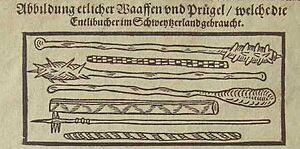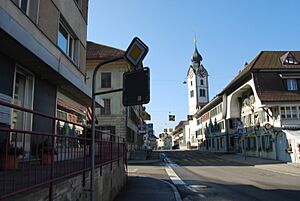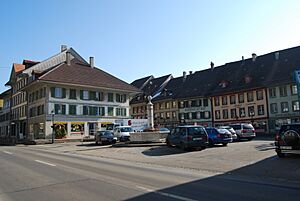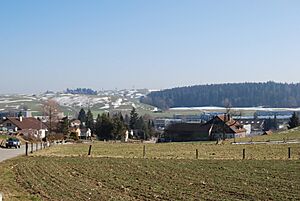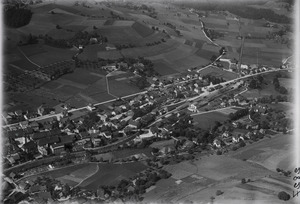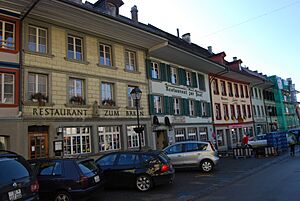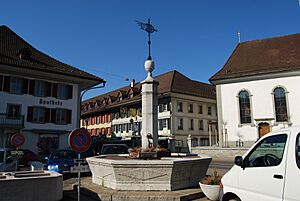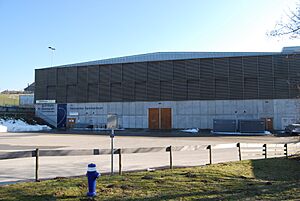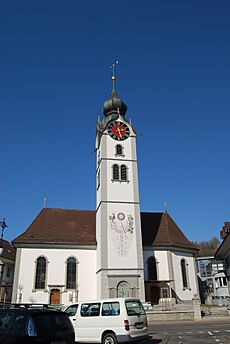Huttwil facts for kids
Quick facts for kids
Huttwil
|
||
|---|---|---|
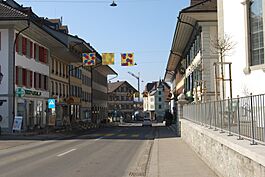
Huttwil town
|
||
|
||
| Country | Switzerland | |
| Canton | Bern | |
| District | Oberaargau | |
| Area | ||
| • Total | 17.24 km2 (6.66 sq mi) | |
| Elevation | 638 m (2,093 ft) | |
| Population
(Dec 2020 )
|
||
| • Total | 5,009 | |
| • Density | 290.55/km2 (752.51/sq mi) | |
| Postal code |
4950
|
|
| Localities | Schwarzenbach | |
| Surrounded by | Auswil, Dürrenroth, Eriswil, Gondiswil, Rohrbach, Rohrbachgraben, Ufhusen (LU), Wyssachen | |
Huttwil is a town in Switzerland, located in the Bern canton. It's part of the Oberaargau administrative district. Huttwil is known for its interesting history and its role in the Swiss Peasant War.
Contents
History of Huttwil
How Huttwil Started
Huttwil was first mentioned in old writings around the 800s. It was called Huttiwilare back then. People probably started living in the Huttwil area even earlier, around the 600s or 700s.
At first, the land belonged to a family called Adalgoze. Later, in the 1000s and 1100s, other powerful families and counts owned parts of Huttwil. Some of these lands were given to Erlach Abbey, which was a monastery. The church in Huttwil was first mentioned around 1093.
Over time, the town grew. In 1313, the Counts of Neu-Kyburg gave Huttwil to the Habsburg family from Austria. But in 1340, soldiers from Bern destroyed Huttwil after a big battle. Even though the town was rebuilt, Bern started to have more and more influence over Huttwil. By 1516, Huttwil became fully part of Bern's territory.
In 1528, Bern changed its religion to Protestantism. Huttwil followed this change. Bern also took over the lands that used to belong to Erlach Abbey.
The Swiss Peasant War of 1653
Huttwil was a very important place during the Swiss peasant war of 1653. This was a time when farmers and common people rebelled against the government because of high taxes and unfair rules.
On April 23, 1653, representatives from different areas like Lucerne, Bern, Basel, and Solothurn met. They decided to work together to achieve their goals. A week later, they met again in Huttwil. There, they chose Niklaus Leuenberger as their leader.
On May 14, 1653, the farmers had another big meeting in Huttwil. They officially formed the "League of Huttwil." They signed a written agreement, like the old treaties of the Old Swiss Confederacy. This agreement showed that they saw themselves as an independent group, equal to the cities. The tax protest had turned into a movement for independence.
Even though the Huttwil League had some early successes, they were defeated in the Battle of Wohlenschwil on June 3, 1653. Bernese soldiers then burned villages and stopped the rebellion. Niklaus Leuenberger, the leader, was executed.
Huttwil After the War
Even though the peasant war failed, it made the Bernese government change how they collected taxes. They also started to respect the rights of the farmers more. Huttwil was not punished further, and its location on the road between Bern and Lucerne helped it grow.
Farming was still important, but Huttwil also became a market town. New businesses started to appear. For a long time, there were tensions between the wealthy town citizens and the poorer farmers who worked their land. In 1828, the citizens lost their special rights, and the shared lands were divided among the farmers.
During the 1800s, many factories and small shops opened in Huttwil. These included places for weaving, spinning wool, and making furniture. Today, manufacturing still provides about one-third of all jobs in Huttwil.
On the night of June 8-9, 1834, a big fire destroyed much of the town. Huttwil was rebuilt with new plans from Bern's city architect. He designed a town center with three main roads and a central plaza with fountains. The houses were built in a style that showed the town's growing wealth. The church was also rebuilt with a taller tower and a new onion dome.
It took a while for Huttwil to get connected to the railway system. The first railway line opened in 1889, followed by others. These railways connected Huttwil to the rest of the country and helped industries grow.
Because Huttwil was becoming a regional center, a secondary school opened in 1873. A hospital opened in 1903. In 1939, a Roman Catholic church was built for the Catholic residents.
Geography
Huttwil covers an area of about 17.3 square kilometers (6.7 square miles). Most of this land, about 64.6%, is used for farming. About 22% is covered by forests. The rest of the area, about 13.6%, has buildings and roads.
Huttwil is located in the lower Emmental region, close to the border with the Canton of Lucerne. The main town is where three rivers, the Langeten, Rotbach, and Wyssachen, meet. Huttwil also includes several smaller villages nearby.
Coat of Arms
The coat of arms for Huttwil shows two silver keys crossed over each other on a blue background. Above them is a golden star.
People of Huttwil
Huttwil has a population of about 4,663 people (as of December 2012). About 9.4% of the people living in Huttwil are from other countries.
Most people in Huttwil speak German as their first language (about 93.6%). A smaller number of people speak Italian or Albanian.
In 2013, about 50.3% of the population was male and 49.7% was female. About 38.9% of the people living in Huttwil in 2000 were also born there.
Children and teenagers (ages 0-19) make up about 20.7% of the population. Adults (ages 20-64) make up 59.3%, and seniors (over 64) make up 20%.
The population of Huttwil has changed over the years, as shown in this chart:

Economy
In 2011, Huttwil had a low unemployment rate of 1.81%. Many people work in Huttwil.
- About 254 people work in the primary sector, which means farming.
- About 1,192 people work in the secondary sector, which includes manufacturing (making things in factories) and construction (building things).
- About 1,634 people work in the tertiary sector, which involves services. This includes jobs in stores, transportation, hotels, restaurants, healthcare, and education.
Many people who live in Huttwil also work there. In 2000, about 54.9% of workers lived and worked in Huttwil. Most people use a private car to get to work (47.2%), while some use public transportation (9.7%).
In 2011, the average income for people in Huttwil was around 118,044 Swiss Francs (CHF) for those earning over 75,000 CHF.
Sights
The entire town of Huttwil is recognized as an important Swiss heritage site. This means its buildings and layout are historically valuable.
Religion
Based on a 2000 census:
- About 71.4% of people belonged to the Swiss Reformed Church (Protestant).
- About 13.0% were Roman Catholic.
- Smaller numbers of people belonged to other Christian churches, or were Muslim, Buddhist, or Hindu.
- About 3.88% of the population did not belong to any church.
Climate
Huttwil gets a good amount of rain or snow each year. Between 1981 and 2010, it had about 140 days of precipitation per year. The wettest month is usually May, and the driest is February.
Education
In Huttwil, many people have a good education. About 57.1% of the population has finished high school (upper secondary education). About 14.3% have gone on to higher education, like a university or a specialized college.
The school system in the Bern canton works like this:
- One year of optional Kindergarten.
- Six years of Primary school.
- Three years of lower Secondary school, where students are grouped by their abilities.
- After secondary school, students can continue their education or start an apprenticeship (learning a trade on the job).
During the 2012–13 school year, there were 638 students in Huttwil. This included students in kindergarten, primary school, and lower secondary school. Many students who live in Huttwil also attend school there.
Huttwil also has a library called Bibliothek Huttwil. In 2008, it had over 15,880 books and other media. It loaned out more than 64,000 items that year.
Notable people
- Fritz Ryser (1873 in Huttwil – 1916): A Swiss cyclist who won a world championship in 1908.
- Anja Nyffeler (born 1992 in Huttwil): A Swiss synchronized swimmer who competed in the 2012 Summer Olympics.
- Cyndi Lauper: The famous singer has ancestors from this area, as revealed on the TV show Finding Your Roots.
See also
 In Spanish: Huttwil para niños
In Spanish: Huttwil para niños






